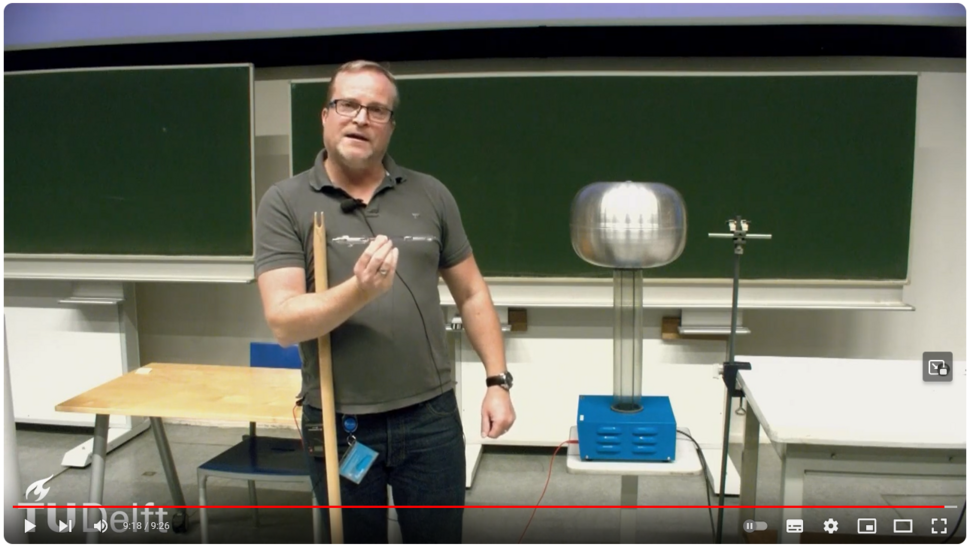Helping students shape their own Learning experience with open education materials
Many students these days want more flexibility and autonomy when it comes to their studies. Added to that, the COVID pandemic amplified the need to make educational materials available online. At that time, Associate Professors Wim Bouwman and Jacob Hoogenboom scrambled to record around 100 lecture videos for their Electricity and Magnetism course at the Faculty of Applied Sciences. To improve the overview and connections within the series of videos and make the materials more accessible, they created an interactive collection using Jupyter book that provides structure and gives students the ability to shape their own learning experience.
It’s an easy way to present a whole variety of content types including videos, mathematical equations, and normal text, and it comes out nicely on the computer screen.
Wim Bouwman
Structure with a story
Even before COVID, Bouwman and Hoogenboom started recording videos as a blended learning project to address the diversity of the student population and support various learning issues. But when the pandemic hit, they sped up their efforts to create a sequence of video lectures fully covering their course contents. They noted that the overview of videos on their YouTube channel lacked context and did not show relations between the videos. To address that, the pair chose to create a Jupyter book for their course materials, putting them together chapter by chapter with a story format.
This structured format makes it easy to follow, navigate, and maintain while students can also easily give feedback for further improvement. “It’s an easy way to present a whole variety of content types including videos, mathematical equations, and normal text, and it comes out nicely on the computer screen,” says Bouwman. Unlike the commonly used LaTeX, which generates material in pdf format, the layout with Jupyter books is always adapting itself. That means it’s easy to access on both small and large screens.
Project support
The Open Education Stimulation Fund award made it possible for the team to realise their project in different ways, say Bouwman and Hoogenboom. Choosing to publish as a Jupyter book was new territory for them, but the Open Education team at the TU Delft Library helped with practical things like getting it on the right servers, maintaining it, and getting the right links for their updated videos. Bouwman notes that the award also enabled them to use teaching assistants to do administrative tasks which can take quite a bit of time. In addition, the structure and timeline of the project motivated them and helped them get clear on what they needed to deliver.
Getting in touch with other people doing similar projects stimulates connections.
Ron Haaksman
Hoogenboom agrees that the support structure was very important. With access to a more advanced recording studio, they were able to produce some new video content like demonstration videos by lecturer Ron Haaksman and they upgraded some existing videos that they found to have insufficient quality. But it was more than that. “Getting in touch with other people doing similar projects stimulates connections,” he says. “And continuing the work that we had already started by turning it into a Jupyter book brings more attention and helps make people aware of what is possible.”
The Jupyter book has helped the pair adapt their teaching and allowed them to better consider individual needs in a classroom of 250 students. In addition to plenary lectures, students can work through the videos and exercises at their own pace with help from student assistants, or they can choose to work from home. “A large majority of first year students still live with their parents, which can be far from campus. They can choose to come to campus when they really need support,” says Hoogenboom. “We’ve received a lot of feedback from students that this way of teaching helps them.”
That freedom to shape it to your own needs and your own learning style is very important. And so far, the feedback from students is very positive.
Jacob Hoogenboom
The open access content that they have created not only improves the learning experience for their students, but the course is now widely available. Other universities can benefit, says Bouwman, particularly Dutch “hogescholen”, or universities of applied sciences. “We have created a nice, easy to access book with a good overview, where you can find all the videos and material,” he says. “Jacob and I are both positive, enthusiastic teachers and I think you can see that in the book. It really reflects us as teachers.” For Hoogenboom, the impact is in allowing students to make their own choice in how they learn and at what pace they learn. “That freedom to shape it to your own needs and your own learning style is very important. And so far, the feedback from students is very positive.”
Contributors:
- Wim Bouwman, Associate Professor, Applied Sciences faculty
- Jacob Hoogenboom, Associate Professor, Applied Sciences faculty
- Ron Haaksman, Lecturer, Applied Sciences faculty
About the Open Education Stimulation Fund (OESF)
In October 2022, the Open Science Programme launched the Open Education Stimulation Fund to enable TU Delft lecturers to innovate their courses with open education. Staff across all faculties were encouraged to submit a proposal for Open Education-related projects for funding up to EUR 20,000 and with a maximum project term of 1 year.

W.G. Bouwman

Ron Haaksman




